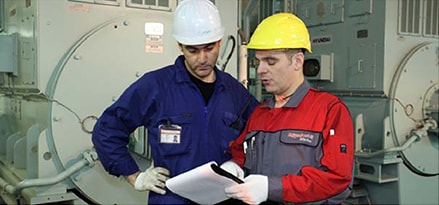Operating guidance for dealing with aluminum and silicon levels above 60ppm
Introduction
We are offering this technical topic to help explain ISO specification 8217 for Marine Fuel Oil, which stipulates 60 ppm for aluminium and silicon combined as a maximum level, taking into account the reproducibility of the test method. In some circumstances, using marine fuel with aluminium and silicon content — referred to as catalytic (cat) fines — above acceptable levels may be unavoidable. In these circumstances, the following guidance may be of use for removing cat fines using the ship’s fuel oil system.
Bunker storage tanks
Cat fines have a higher density than the fuel oil medium they are contained within. They will readily settle if water is not present. To aid settling, maintain bunker tank storage temperatures at 45 degrees Celsius. Ensure tank temperatures do not exceed 55°C to avoid approaching the lower limit flash point of 60°C as stipulated in ISO 8217.
Settling tanks
Cat fines are hydrophilic and emulsify readily on contact with water. Removal efficiency falls as water content increases.
- Maintain settling tank temperature above 85°C to aid settling and water content removal.
- If a two-settling tank system is available, utilize both tanks on a rotational basis to extend the settling time for the fuel oil product.
- Ensure strict housekeeping so that settling tanks are drained at regular intervals when operating on high-cat-fine-content fuel (draining every two hours may be required).
Fine backwashing/self-cleaning filter
- Avoid inappropriate operation of the fine backwashing filter.
- Avoid bypassing filters; typically, this is your engine’s last line of defence.
- It is recommended that backwash oil not be recycled or reused.
Purifiers
- Do not stir or homogenise fuel oil upstream of purifiers.
- Ensure purifier inlet temperature is maintained at 95°C.
- Manage purifier throughput rates to try to achieve a quarter of the machine’s rated throughput or less. At this throughput, independent tests have shown that purifiers can achieve 80 per cent removal efficiency on average.
- Operate purifiers in parallel. This will improve the removal rate as it increases the residence time of the oil within the purifier bowl. Even with multiple purifiers operating in parallel, reduce their throughput to the level that is just sufficient to keep pace with the engines’ fuel consumption.
Average differences in removal rates:
• Single unit = 70 per cent efficiency
• Two units in series = 80 per cent efficiency
• Two units in parallel = 85 per cent efficiency
- Take samples of fuel oil at the purifier inlet and outlet. This will show purifier efficiency and will give an indication of the level of cat fines introduced to the engine pre-filter.
Service tank
- Maintain service tank temperature above 90°C to aid settling and water content removal.
- Ensure strict housekeeping so that service tanks are drained at regular intervals when operating on high-cat-fine-content fuel (draining every two hours may be required).
Operational problems
- If removal is unsuccessful, a high level of cat fines may be introduced to the fine backwash filter, causing it to go into continuous back flush mode.
- Reduce engine power until the filter can cope with the level of contamination and remain online.
- Note: Bypassing the filter will introduce contaminated fuel to the engine, which may cause wear to the fuel injection system and the cylinder components of the engine.
Other advice
- If correctly operated, the ship’s fuel oil system is effective at removing significant levels of cat fines.
- Ensure that fuel oil sludge drains are not recycled for diesel engine consumption via the settling tank.
- Cat fine content can be reduced by blending in fuel oil with a lower cat fine content.
- Resultant cat fine content will be based on the sum of the cat fine contents against the blend ratio.


